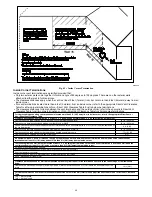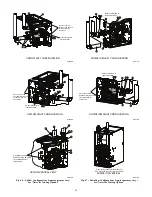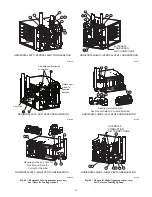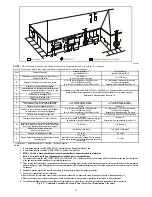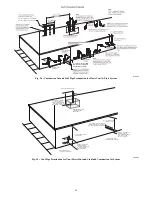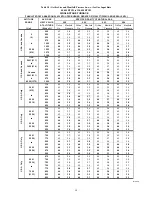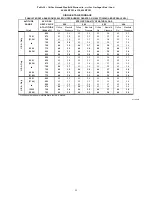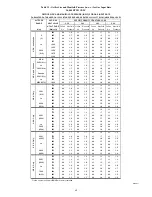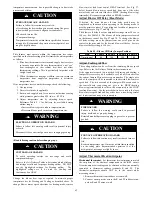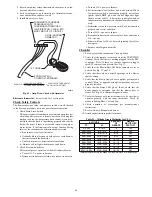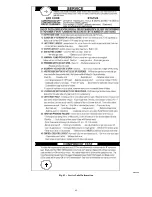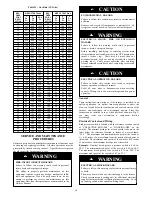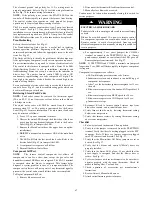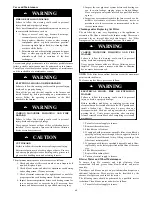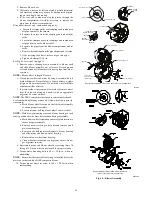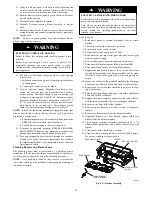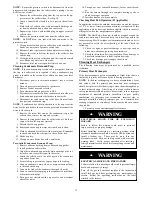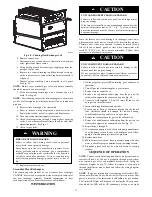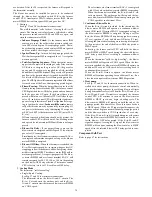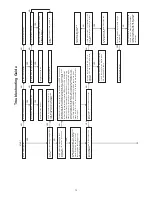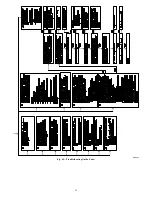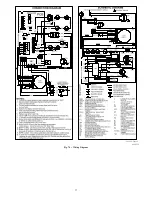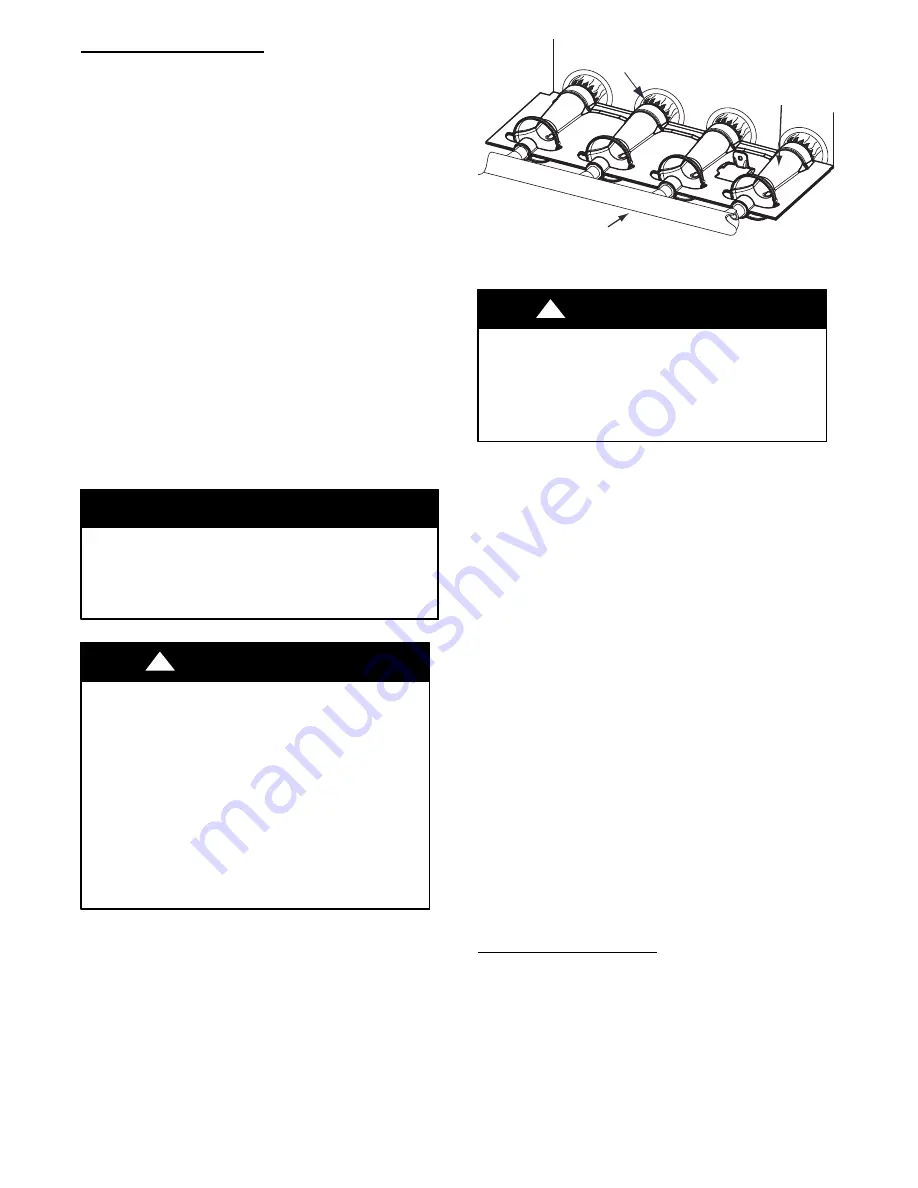
62
Adjust Manifold Pressure
NOTE
:
There are two manifold pressure tables in these
instructions.
USE TABLE 19 FOR THE LOW CAPACITY
26,000 BTUH MODELS
.
The low capacity model can be
identified by the green label affixed to the top of the gas valve. For
all other models, see Table 18.
1. Adjust manifold pressure to obtain proper gas input rate.
See Fig. 60.
a. Refer to the correct manifold pressure table for the appro-
priate model.
b. Turn gas valve ON/OFF switch to OFF.
c. Loosen set screw on manifold tower pressure tap no
more than one full turn with a 3/32--in. hex wrench, or
remove the 1/8 inch NPT plug from the manifold
pressure tap on the gas valve.
d. Connect a water column manometer or similar device to
manifold pressure tap.
e. Turn gas valve ON/OFF switch to ON.
f. Manually close blower door switch.
g. Jumper R and W thermostat connections on control to start
furnace. See Fig. 37.
h. Remove regulator adjustment cap from gas valve pressure
regulator and turn adjusting screw (3/16 or smaller flat--
tipped screwdriver) counterclockwise (out) to decrease in-
put rate or clockwise (in) to increase input rate. See Fig.
60.
For 40,000 BTUH models through 120,000 BTUH models:
DO NOT set manifold pressure less than 2.8--in. w.c. (697 Pa)
or more than 3.8 in. w.c. (947 Pa) for natural gas. If required
manifold pressure is outside this range, change main burner
orifices to obtain manifold pressure in this range.
NOTICE
FURNACE DAMAGE HAZARD
Failure to follow this caution may result in reduced furnace
life.
The 26,000 BTUH model has a lower nominal manifold
pressure than other models. Do not adjust the natural gas
manifold pressure above 1.8--in. W.C.
The 26,000 BTUH model can be identified by the green
label affixed to the solenoid of the gas valve.
Refer to the Adjustment section for setting the manifold
pressure.
USE TABLE 19 WHEN ADJUSTING 26,000 BTUH
MODEL MANIFOLD PRESSURE.
CAUTION
!
i. When correct input is obtained, replace cap that conceals
gas valve regulator adjustment screws. Main burner flame
should be clear blue, almost transparent See Fig. 61.
j. Remove jumper R to W.
Burner Flame
Burner
Manifold
A11461
Fig. 61 -- Burner Flame
FIRE HAZARD
Failure to follow this warning could result in personal
injury, death, and/or property damage.
Manifold pressure tap set screw must be tightened and
1/8--in. NPT pipe plug must be installed to prevent gas
leaks.
!
WARNING
NOTE
: Contact your HVAC distributor or gas supplier for metric
gas meter Tables, if required.
2. Verify natural gas input rate by clocking meter.
a. Turn off all other gas appliances and pilots served by the
meter.
b. Jumper R to W.
c. Run furnace for 3 minutes.
d. Measure time (in sec) for gas meter to complete one revolu-
tion and note reading. The 2 or 5 cubic feet dial provides
a more accurate measurement of gas flow.
e. Refer to Table 22 for cubic ft. of gas per hr.
f. Multiply gas rate cu ft./hr by heating value (Btuh/cu ft.)
to obtain input rate.
g. If clocked rate does not match required input from Step 1,
increase manifold pressure to increase input or decrease
manifold pressure to decrease input. Repeat steps b through
e until correct input is achieved. Re--install regulator seal
cap on gas valve.
3. Restore furnace to normal operating condition.
a. Turn gas valve ON/OFF switch to OFF.
b. Remove water column manometer or similar device from
manifold pressure tap.
c. Tighten set screw on manifold tower pressure tap with
3/32--in. hex wrench, or if 1/8--in. NPT plug was removed,
apply pipe dope sparingly to end of plug and reinstall in
the gas valve.
d. Turn gas valve ON/OFF switch to ON.
e. Check for gas leaks and verify furnace operation.
Adjust Temperature Rise
NOTE
: Blower door must be installed when taking temperature
rise reading. Leaving blower door off will result in incorrect

